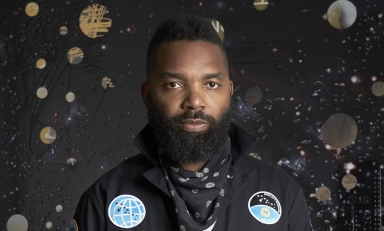Named this month by ArtNews as “One of 15 Los Angeles Artists to Watch,” Candice Lin is Occidental College’s 2018-19 Wanlass Artist in Residence. Presented by Oxy Arts, the college's interdisciplinary hub for the arts on campus and in the community, Lin’s exhibition, “The inscrutable speech of objects,” will open in the College’s Weingart Gallery January 31.
An assistant professor of art at UCLA, Lin is an interdisciplinary artist who works with installation, drawing, video, and living materials and processes such as mold, mushrooms, bacteria, fermentation, and stains. Her work most recently has been the subject of solo exhibitions in Frankfurt, Paris and London.
An opening reception for “The inscrutable speech of objects” will be held on January 31 from 5 to 8 p.m. in Weingart Gallery on the Occidental campus. The exhibition will run through April 5.
Lin “braids together little-known histories, feminist theory, and scientific investigations in installations with crisscrossing narratives that span continents and centuries,” says ArtNews in its new listing of 15 of Los Angeles’ “most perceptive and probing artists.”
Building on some of her more recent work, the new exhibition “traces the materialist history of colonial goods, such as indigo, opium, sugar, porcelain, and tea,” Lin explains. “It looks at the entangled connections between these items and the racialized language around their dispersal and value.”
The installation features a table composed of clay tablets, a glass distillation system brewing a dark brown liquid, and a pumping system that distributes this fluid through a system of tubing and buckets that empties on top of a large wooden structure.
The table of clay tablets appears to be written in cuneiform but is actually written in English. It quotes from John Searle’s 1980 essay Minds, Brains, and Programs that used the inscrutability of the Chinese language to question what qualifies as a human level of sentience or consciousness.
The distillation system boils a mixture of poppies, sugar cane and tobacco--crops that relate to a history of dehumanization and span connections between China, India, the Caribbean, Great Britain and the United States. The distillate circulates through the room before dripping onto the wooden structure, which references a water torture device used in 19th century prisons. On top of this structure is a block of unfired porcelain that slowly erodes from the unrelenting drops.
Surrounding the installation are research materials, plant tinctures, natural specimens, five small drawings and a large-scale fragment of handmade paper created from boiling together the shredded plant matter of poppy stems, sugar cane, indigo, and yucca. The smaller drawings are rendered using ink created by crushing oak galls found on the Occidental campus, a technique used on European medieval manuscripts.
“Each of these drawings records my experience after ingesting a plant tincture or flower essence and is an attempt to expand the idea of research to imagine what is missing from archives and books,” Lin says. “Many of the plants come from my research into poisons, abortifacients, medicines and drugs associated with the histories of slavery and coolie labor, or may have been used during slave and worker uprisings or for actions of resistance or healing.”
“The exhibition attempts to imagine, in the words of feminist literary scholar Saidiya Hartman, ‘what cannot be verified … to reckon with precarious lives which are only visible in the moment of their disappearance’—to think into being what noted theorist Lisa Lowe describes as ‘the matters absent, entangled and unavailable,’” Lin says. ‘It does so through a recognition of the withdrawal, allure and opacity that certain materials contain, and activates these objects and histories into new orientations.’
In addition to Lin’s solo show, Oxy Arts will present Ako Castuera’s exhibition, "Soil", also opening in the Weingart Gallery on January 31. “Soil” is physically connected to Lin’s exhibition by recycling its waste materials (leftover food from the reception, or plant matter used in the sculptures) as food for the worms living in Castuera’s ceramic worm composting sculpture. The worms will break the waste down into usable rich soil. Castuera was one of the artists Lin invited to present in her classroom last fall as an extension of the collaborative teaching methodology of the Wanlass residency.
The Wanlass Artist in Residence is Occidental’s semester-long residency program that allows an artist to investigate aspects of their practice and share it with the College campus-wide through a fall semester course and a spring semester exhibition. The program encourages cross-campus collaboration and thoughtful sustained interaction between artist and students. The Wanlass Artist in Residence Program is made possible by generous support from the Kathryn Caine Wanlass Charitable Foundation.




